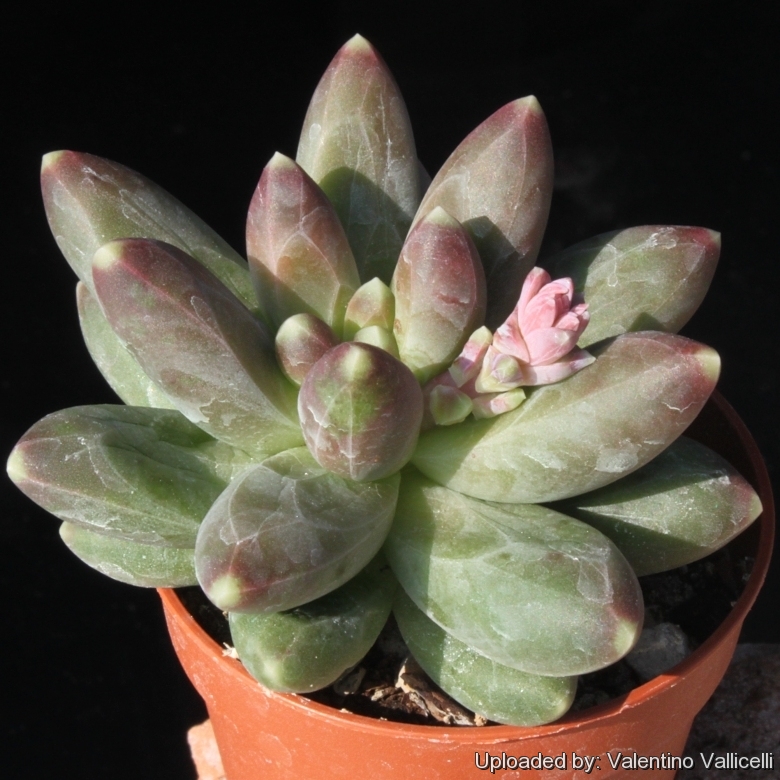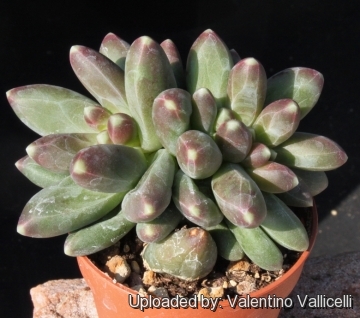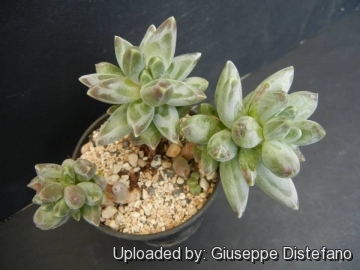
Pachyphytum compactum Photo by: Valentino Vallicelli
Origin and Habitat: Mexican states of Queretaro and Hidalgo.
Habitat: Grows on shady cliffs in altitudes of 2000 meters.
Synonyms:
See all synonyms of Pachyphytum compactum
back
Accepted name in llifle Database:Pachyphytum compactum RoseContr. U.S. Natl. Herb. 13: 301, pl. 61. 1911Synonymy: 2
back
Description: Pachyphytum compactumSN|22247]]SN|22247]] is a short stemmed, tightly branched, succulent with closely set rosette near the crown. This succulent tend to grow both in height and in width, giving origin to a rounded shrub. Leaves are distinctively patterned with lots of nice colour (especially when stressed by cold or drought).
Stems: Compact, rarely above 10-12 cm (or longer if pendent especially in cultivation)
Rosettes: Of 20-60 very close leaves set at right angles to the stem 2,5-5 cm across.
Leaves: Very fleshy, short cylindrical to chubby pointed, but somewhat flattened grey-green heavily veined with white and more or less purplish, somewhat glaucous, 2 to 2,5 cm long; The imprint from the neighbouring leaves gives the plant a distinctive appearance.
Flowers: Its short flower stalk bears but few flowers, dark red with greenish tips with typical scale-like appendages.
Blooming season: Spring.
Remarks: Leaves easily fall off the stem, but soon throw out roots from the base and form young plantlets, a means of propagation characteristic of the Crassulaceae.
Basic chromosome number: n = 31.
Subspecies, varieties, forms and cultivars of plants belonging to the Pachyphytum compactum group
Notes: The white pruinose stem coatings of the plants in our collection sometime is not so intense as those of the plants in their natural habitat but the difference in coating is thought due to the higher humidity and less intense sunlight of our climate.
Bibliography: Major references and further lectures
1) James Cullen, Sabina G. Knees, H. Suzanne Cubey "The European Garden Flora Flowering Plants: A Manual for the Identification of Plants Cultivated in Europe, Both Out-of-Doors and Under Glass" Cambridge University Press, 11/ago/2011
2) Hermann Jacobsen ”A Handbook of Succulent Plants: Abromeitiella to Euphorbia” Blandford Press, 1960
3) Christopher Brickell "RHS Encyclopedia of Plants and Flowers" Dorling Kindersley Ltd, 01/set/2010
4) A. J. van Laren "Succulents other than cacti" Abbey San Encino Press, 1934
5) John Robert Brown, Alain Campbell White, Boyd L. Sloane, George W. Reynolds "Succulents for the amateur: introducing the beginner to more than eight hundred fascinating succulent plants" Abbey garden press, 1946
6) Urs Eggli “Illustrated Handbook of Succulent Plants: Dicotyledons” Volume 2. Springer, 2002
7) H. W.Fittkau "Encuentro con cactáceas y suculentas en Territorio de Colón, Qro." in Cact. Suc. Mex., 8: 39-47, 55-56, figs. 26-31, 35. 1963
8) Contributions from the U. S. National Herbarium 13(9): 301, pl. 61, 1911
9) R. Moran "Pachyphytum compactum Rose (Crassulaceae)." In: Cact. Succ. J. (U.S.A.), 63. (1): 30-34, 1991 (illus., col.illus. Icones, Chromosome numbers, Anatomy and morphology.)
10) C. H. Uhl & R. Moran "The chromosomes of Pachyphytum (Crassulaceae)" in Amer. J. Bot., 60: 648-656, 1973, figs. 1-31.
 Pachyphytum compactum Photo by: Valentino Vallicelli
Pachyphytum compactum Photo by: Valentino Vallicelli Pachyphytum compactum Photo by: Giuseppe Distefano
Pachyphytum compactum Photo by: Giuseppe DistefanoCultivation and Propagation: Easy to grow. Does great in succulent pots with other similar plants like Echeverias. It is fairly hardy, and is a common houseplants.
Soil: It will require a free draining compost.
Moisture: It needs regular water in summer, but reduce watering during winter month, but fairly drought tolerant elsewhere.
Sun exposure: It love full sun, with some shade during the hottest part of the day. A good light exposure helps to keep the plants compact and encourage leaf colour and flowering.
Hardiness: During winter protect from freezing.
Maintenance: Like Graptopetalum and Echeveria, Pachyphytum is sensitive to being handled, as skin oil can damage leaves, in particular those with a pearlescent colouration or farina. After growing for several years tend to become untidy, and should be cut very short or restarted from cuttings.
Propagation: Cuttings, seeds. New plants can be also propagated from orphaned leaves.












